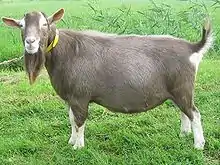 | |
| Conservation status | FAO (2007): not at risk[1]: 146 |
|---|---|
| Other names |
|
| Country of origin | Switzerland |
| Distribution | worldwide |
| Standard | Schweizerischer Ziegenzuchtverband |
| Use | milk |
| Traits | |
| Weight | |
| Height | |
| Horn status | horned or hornless |
| Tassels | with or without tassels |
| |
The Toggenburger or Toggenburg is a Swiss breed of dairy goat. Its name derives from that of the Toggenburg region of the Canton of St. Gallen, where it is thought to have originated. It is among the most productive breeds of dairy goat and is distributed world-wide, in about fifty countries in all five inhabited continents.[3]
History


The Toggenburger is the traditional goat breed of the Toggenburg and Werdenberg regions of the Canton of St. Gallen in eastern Switzerland.[4] The herd-book was started in 1890.[5]: 414 At first, the goats were often dark-coated, sometimes with white markings; there may have been some cross-breeding with Appenzell and Chamois-coloured stock in neighbouring areas. The typical mouse-grey colour with white facial markings was fixed by selective breeding in the twentieth century.[5]: 414
In 2006 there were 850 of the goats in the Toggenburg and the Werdenberg regions, out of a total of 3000 in Switzerland; this is much lower than in the 1950s, when there were more than 20000.[4] The Verein Ziegenfreunde is an association of owners of the goats within their historic area of origin.[4]
The Toggenburger is distributed world-wide, in about fifty countries in all five inhabited continents,[3] among them most countries of Europe and of Central America, the West Indies and South America. Herd-books have been established in Austria, Australia, Belgium, Canada, South Africa and the United States (where the first imports were in 1904);[5]: 414 [6]: 9 in Holland and the United Kingdom distinct national breeds have developed.[5]: 414 The British Toggenburg was recognised as a breed in 1921; it is somewhat larger and heavier than the original Swiss goat, and has a higher milk yield.[5]: 365 [7]: 138 [8]: 196
Characteristics
The Toggenburger is of medium size. Coat colour ranges from light brown to mouse grey, with white Swiss markings to the face, lower legs and tail area.[2] Tassels may be present; billies and nannies may be naturally horned or polled (hornless).[2]
Use
It is a highly productive dairy breed. The breed standard calls for minimum milk yield of 740 kg per lactation, with a minimum fat content of 3.56% and minimum protein content of 2.90%.[2]
References
- ↑ Barbara Rischkowsky, D. Pilling (eds.) (2007). List of breeds documented in the Global Databank for Animal Genetic Resources, annex to The State of the World's Animal Genetic Resources for Food and Agriculture. Rome: Food and Agriculture Organization of the United Nations. ISBN 9789251057629. Accessed May 2014.
- 1 2 3 4 5 6 7 Toggenburger Ziege (in German). Schweizerischer Ziegenzuchtverband. Archived 2 October 2016.
- 1 2 Transboundary breed: Toggenburg. Domestic Animal Diversity Information System of the Food and Agriculture Organization of the United Nations. Accessed August 2022.
- 1 2 3 Slow Food Presidia: Toggenburg Goat. Fondazione Slow Food per la Biodiversità Onlus. Archived 30 January 2015.
- 1 2 3 4 5 Valerie Porter, Lawrence Alderson, Stephen J.G. Hall, D. Phillip Sponenberg (2016). Mason's World Encyclopedia of Livestock Breeds and Breeding (sixth edition). Wallingford: CABI. ISBN 9781780647944.
- ↑ Irmagarde Richards (1921). Modern Milk Goats. Philadelphia; London: J.B. Lippincott Company.
- ↑ Valerie Porter, Ian Lauder Mason (2020). Mason's World Dictionary of Livestock Breeds, Types and Varieties (sixth edition). Wallingford; Boston: CABI. ISBN 9781789241532.
- ↑ Sue Weaver (2021). The Goat: A Natural History. Brighton: Ivy Press. ISBN 9781782407522.